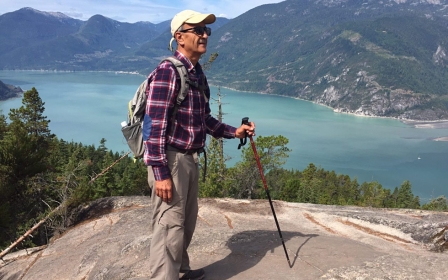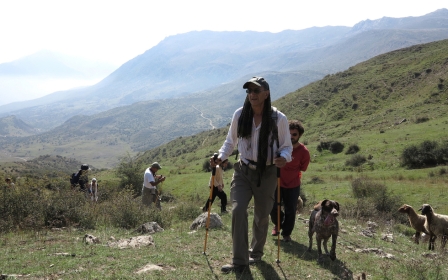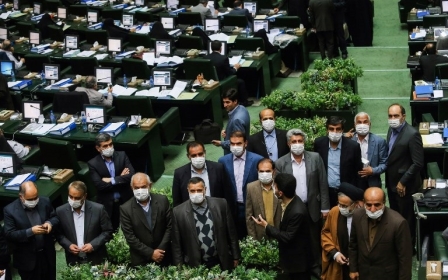Will the environment become a new US-Iran battlefront?

A recent string of arrests of prominent environmentalists and wildlife activists on security-related charges has stirred deep anxiety and uncertainty among Iranian civil society. The latest arrests occurred in the wake of the detention of eight environmental activists in late January on espionage charges.
Before these highly publicised arrests, Iran's vibrant pro-environmental community was one sector of civil society that had managed to avoid state scrutiny.
The stakes were raised further after the death of academic Kavous Seyed-Emami in prison a few days after his arrest. Seyed-Emami, who had been detained on spying charges, is alleged to have committed suicide in his cell following an interrogation session.
Targeting by Western intelligence
The prevailing opinion in the West appears to be that the government is using security concerns as a cover to crack down on environmental activism. This is allegedly based on the authorities' fear that environmental issues are set to become more and more politically sensitive in the months and years ahead.
However, there are more nuanced explanations behind these unusual arrests, which do not reflexively dismiss the concerns of the Iranian security establishment. It is not inconceivable that Iranian environmental causes are being aggressively targeted by Western intelligence services with an aim to gathering intelligence and manipulating these causes to apply pressure on Iran.
Environmental issues are being politicised by a wide range of Iranian stakeholders, including professional environmental campaigners, opposition groups and even sections of the Iranian government
The film Argo depicts the sheer artistry of the Central Intelligence Agency at its best. Based on a true story, the film follows a CIA exfiltration specialist as he plans the escape of six American embassy staff sheltering at the home of the Canadian ambassador in Tehran. To accomplish his daring plan, the CIA officer concocts a movie project in collaboration with a Hollywood producer.
Although the CIA has a chequered history in post-revolutionary Iran – the agency's network was dismantled by Iranian counter-intelligence in the late 1980s – Argo speaks to its ingenuity and resourcefulness.
Despite the huge setback in the 1980s, the CIA never stopped targeting Iran in aggressive and innovative ways. A recent feature in the Guardian details how the CIA targets and recruits Iranian scientists on the fringes of both real and bogus academic conferences.
Penetrating critical sectors
Such aggressive targeting is part of the CIA's broader plan to penetrate, manipulate, and even sabotage critical segments of the Iranian scientific community that interface with the country's military and nuclear industry.
For example, the Stuxnet virus, which targeted Iranian centrifuges used for uranium enrichment, was developed jointly by the Israeli Mossad and the CIA after exhaustive targeting of key areas of the Iranian scientific community.
Furthermore, the campaign to assassinate Iranian nuclear scientists – widely believed to have been carried out by Mossad with possible help from the CIA – involved the recruitment of Iranian scientists and academics in its early phase.
So how credible are Iranian claims that part of the country's environmental community has been penetrated by Western intelligence services? The hardline press in Tehran is keen to establish a strong link, if only to lend credence to the actions of the intelligence section of the Islamic Revolutionary Guards Corps (IRGC) and the judiciary.
The headline relates to a widely publicised campaign to save the endangered Persian Leopard. Shariatmadari argues the campaign was penetrated by Western intelligence services, which used it as a cover to gather information on the country's military, notably the highly sensitive ballistic missile programme.
Espionage charges
The plot thickens with the man at the centre of the espionage case, Seyed-Emami, who by most credible accounts was something of an enigma. A dual Iranian-Canadian national, Seyed-Emami was a well-established sociologist who appears to have spent most of his free time campaigning for environmental causes.
Most intriguing, he was affiliated to the Imam Sadiq University (ISU), a prestigious and sensitive institution known to train Iran's political and diplomatic elites.
If the espionage charges against Seyed-Emami had any validity, they were likely to have been based, at least in part, on his affiliation to the ISU, which would have given him easy and ready access to the crème de la crème of the Islamic Republic's political and diplomatic communities.
There are grounds for exercising a degree of scepticism in relation to the charges levelled against Seyed-Emami and the other environmental and wildlife activists. For a start, they were all reportedly arrested by the intelligence section of the IRGC, not the Ministry of Intelligence and Security (MOIS).
The distinction is important, as the MOIS is the sole agency with the mandate and expertise to investigate suspected cases of espionage by foreign powers. However, in practice, the IRGC's intelligence branches are sometimes involved in counter-espionage operations, usually at the behest of the MOIS and not in competition with it, as it is often erroneously reported in the West.
The lead role of the IRGC in this case is unusual, and it speaks to the complexity of the case and its potential intersection with political or other unknown considerations. In short, on the face of it at least, there are enough peculiarities to suspect that this is not a straightforward intelligence matter.
Rapid politicisation
Environmental issues are being politicised by a wide range of Iranian stakeholders, including professional environmental campaigners, opposition groups and even sections of the Iranian government. It is noteworthy that environmental issues are often considered to be one of the causal roots of the protests that rocked the country early in the new year.
The sensitivity ensuing from this rapid politicisation has inevitably attracted the attention of the intelligence sections of the IRGC, who are fearful that even relatively "soft" issues such as the environment and wildlife protection can be weaponised against the Islamic Republic.
Politics aside, it would be foolish to reflexively dismiss the potential intelligence dimensions of this case. By all credible accounts, the CIA's Iran department – reportedly led by one "Ayatollah Mike" – is under strict instructions to aggressively target the Islamic Republic with a view to fomenting uncertainty and destabilisation.
In view of the prevailing geopolitical context – and the CIA's expanded operational priorities – it would be very surprising if Iran's vibrant environmental protection sector had entirely escaped the attention of US intelligence.
- Mahan Abedin is an analyst of Iranian politics. He is the director of the research group Dysart Consulting.
The views expressed in this article belong to the author and do not necessarily reflect the editorial policy of Middle East Eye.
Photo: A general view shows a blanket of smog as the winter's heavy pollution hit new heights in Tehran on 19 December, 2017 (AFP).
This article is available in French on Middle East Eye French edition.
New MEE newsletter: Jerusalem Dispatch
Sign up to get the latest insights and analysis on Israel-Palestine, alongside Turkey Unpacked and other MEE newsletters
Middle East Eye delivers independent and unrivalled coverage and analysis of the Middle East, North Africa and beyond. To learn more about republishing this content and the associated fees, please fill out this form. More about MEE can be found here.






